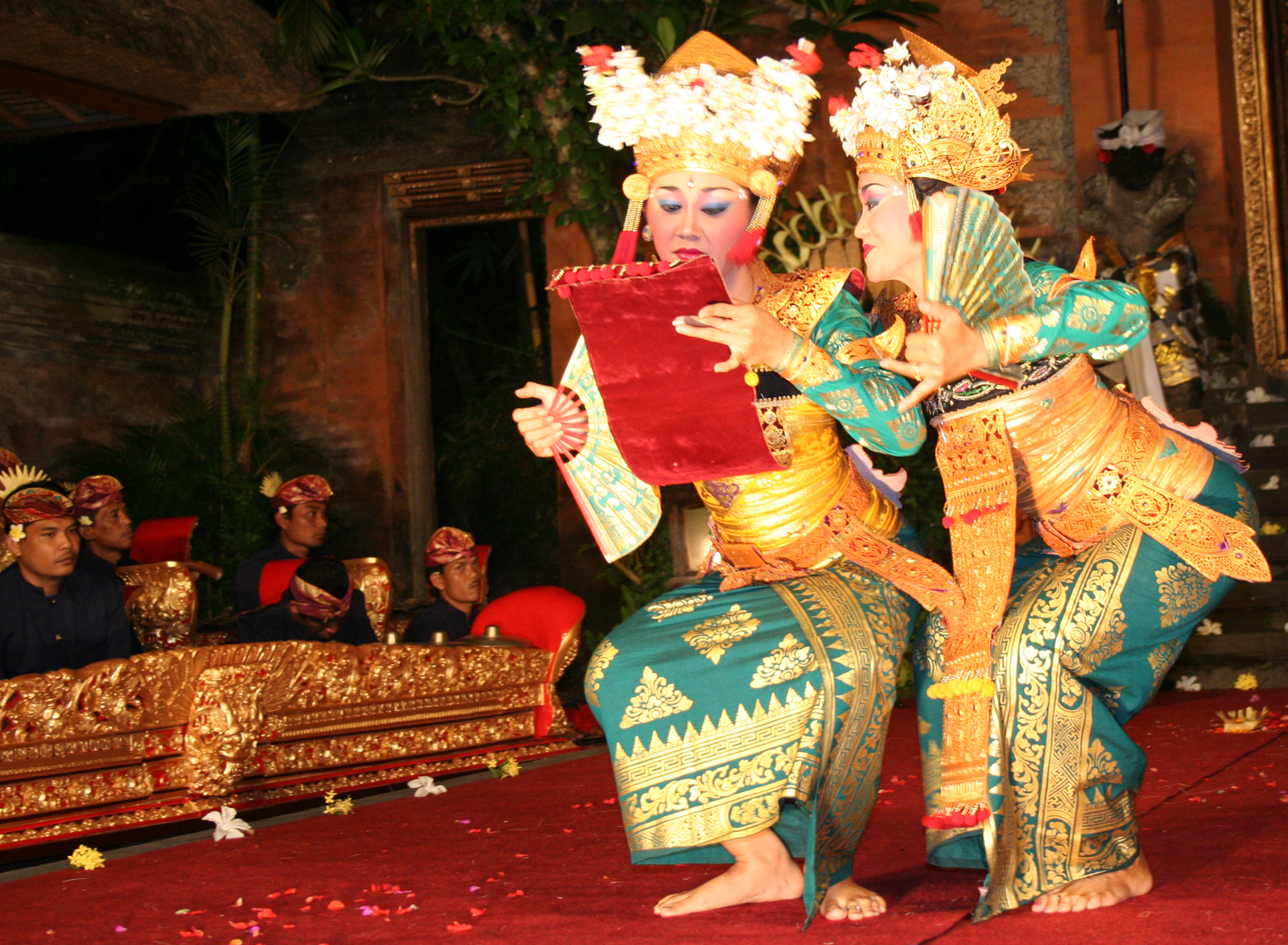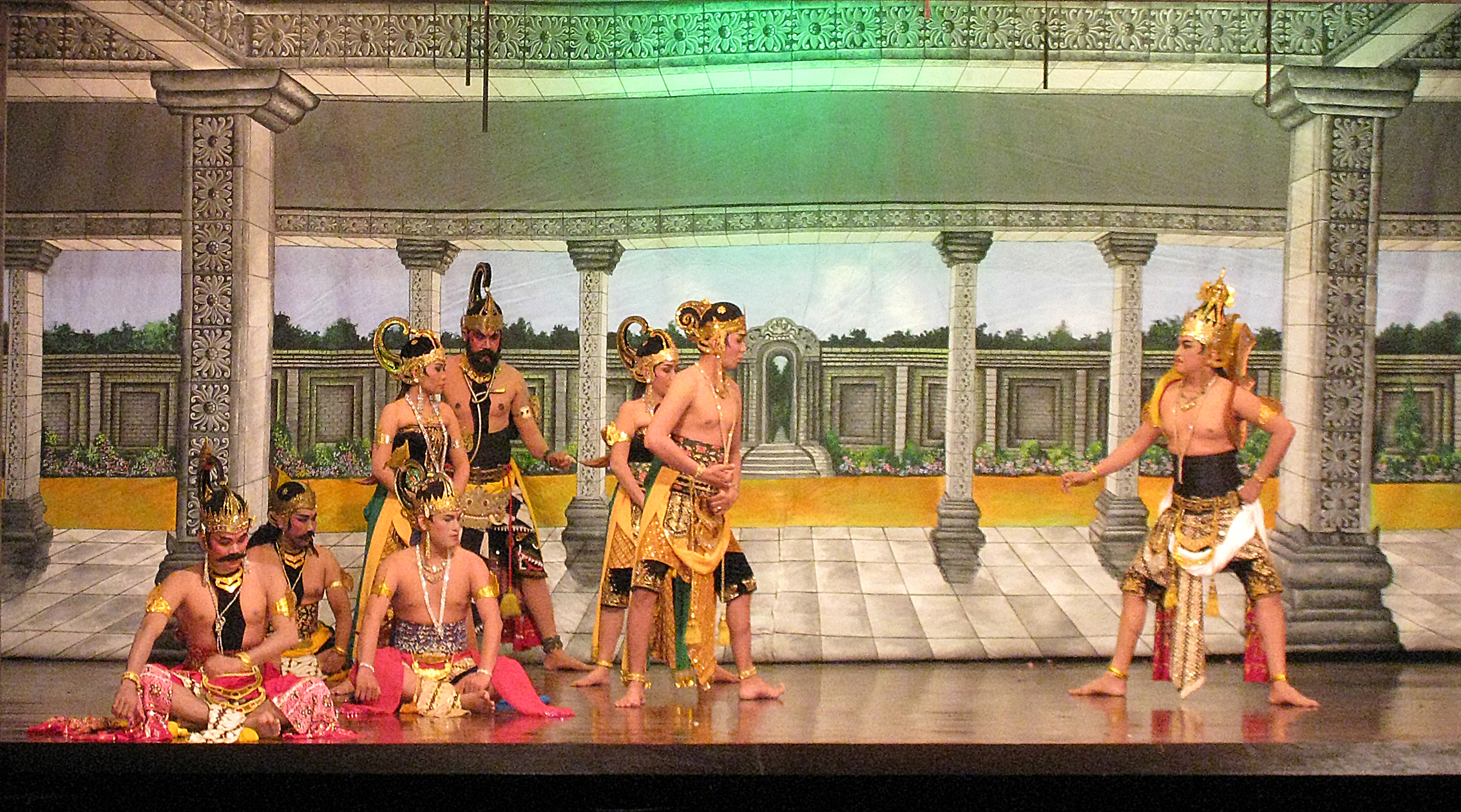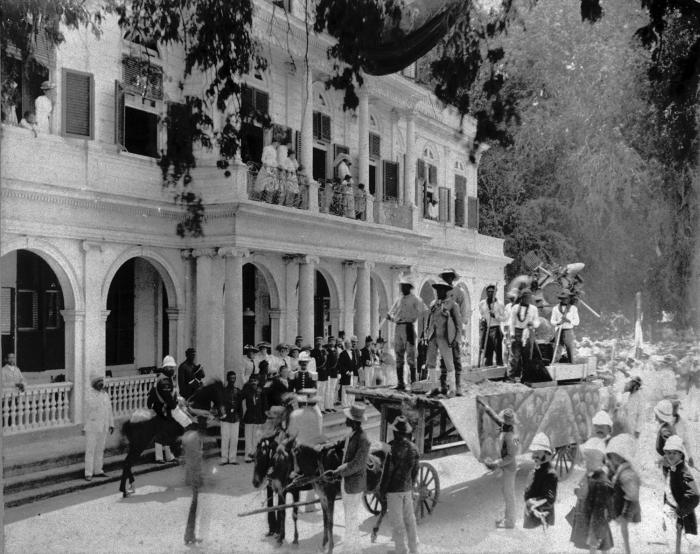|
Janger
( ban, ᬚᬗᬾᬃ) is a traditional Balinese and Osing dance drama performance originated from the Indonesian island of Bali, and commonly performed by Balinese in Bali as well as Osing people in the easternmost region of Java. The term roughly translates to '"infatuation," with a connotation of someone who is ''madly'' in love” :97 History ''Janger'' is a social dance created in the 1920s, though its exact date of origin is unknown:17, 161 I Madé Kredek claims it 'originated in the village of Menyali, North Bali and the songs featured in it were those of the horse drivers in the area.':101 Performance ''Janger'' is a 'flirtatious youth group dance';:92 it begins with a tableau vivant and a welcoming song.:161 This is followed by 12 male dancers (''kecak'') who perform an elaborate routine; when finished, they sit in two rows of six facing each other, and a female group (''janger'') enters and sings a traditional folk song,:161 and perform a slower dance with a ... [...More Info...] [...Related Items...] OR: [Wikipedia] [Google] [Baidu] |
Gamelan
Gamelan () ( jv, ꦒꦩꦼꦭꦤ꧀, su, ᮌᮙᮨᮜᮔ᮪, ban, ᬕᬫᭂᬮᬦ᭄) is the traditional ensemble music of the Javanese, Sundanese, and Balinese peoples of Indonesia, made up predominantly of percussive instruments. The most common instruments used are metallophones played by mallets and a set of hand-played drums called '' kendhang/Kendang'', which register the beat. The kemanak (a banana-shaped idiophone) and gangsa (another metallophone) are commonly used gamelan instruments in Bali. Other instruments include xylophones, bamboo flutes, a bowed instrument called a ''rebab'', a zither-like instrument ''siter'' (in Javanese ensemble) and vocalists named '' sindhen'' (female) or ''gerong'' (male).Sumarsam (1998)''Introduction to Javanese Gamelan'' Middletown. Although the popularity of gamelan has declined since the introduction of pop music, gamelan is still commonly played in many traditional ceremonies and other modern activities in Indonesia, b ... [...More Info...] [...Related Items...] OR: [Wikipedia] [Google] [Baidu] |
Osing People
The Osing or Using ( Osing: ; ) are indigenous ethnic group native to easternmost part of the Java island (especially in Banyuwangi), Indonesia. They are the descendants of the people of the ancient Kingdom of Blambangan. The population of Osing people are approximately 400,000 which concentrated in the Banyuwangi Regency of East Java Province. Demography The Osing people are settled in several districts in the central and northern regions of Banyuwangi Regency especially in Banyuwangi district, Rogojampi district, Sempu district, Glagah district, Singojuruh district, Giri district, Kalipuro district and Songgon district. The Osing community or also commonly known as Laré Osing by some circles and as a result of research, are considered as the natives of Banyuwangi Regency, including an area at the easternmost tip of the Java island that is also known as Blambangan Peninsula. This community of people are spread throughout fertile farming villages in the central and eastern re ... [...More Info...] [...Related Items...] OR: [Wikipedia] [Google] [Baidu] |
Balinese Dance
Balinese dance ( id, Tarian Bali; ban, ᬇᬕᬾᬮᬦ᭄ᬩᬮᬶ) is an ancient dance tradition that is part of the religious and artistic expression among the Balinese people of Bali island, Indonesia. Balinese dance is dynamic, angular and intensely expressive. Balinese dancers express the stories of dance-drama through the bodily gestures including gestures of fingers, hands, head and eyes. There is a great richness of dance forms and styles in Bali; and particularly notable are those ritualistic dance dramas which involve Rangda, the witch, and the great beast Barong. Most of the dances in Bali are connected to Hindu or traditional folk rituals, such as the Sanghyang Dedari sacred dance that invoke benevolent hyang spirits, believed to possess the dancers in a trance state during the performance. Other Balinese dances are not linked to religious rituals and are created for certain occasions or purposes, such as the Baris or Pendet welcoming dances and Joged ... [...More Info...] [...Related Items...] OR: [Wikipedia] [Google] [Baidu] |
Theatre In Indonesia
''Indonesian theatre'' is a type of art in the form of drama performances that are staged on a stage, with a distinct Indonesian nuance or background. In general, theatre is an art that emphasizes the performing arts that are displayed in front of a large crowd. In other words, theater is a form of visualisation of a drama that is staged on the stage and watched by the audience. Indonesian theatre includes the performing arts of traditional theater and modern theatre located in the territory of Indonesia (also called Nusantara). Some examples of Indonesian theater are Arja, Wayang, Wayang wong, Lenong, Ludruk, Janger, Randai and others. Theatre in Indonesia can also be referred to as regional or ethnic theatre, because it originates and develops from 1,300 ethnic cultures in Indonesia. History Theatre performances in Indonesia have been going on for thousands of years. Most of Indonesia's oldest theatre forms are linked directly to local literary traditions (oral and writ ... [...More Info...] [...Related Items...] OR: [Wikipedia] [Google] [Baidu] |
Kendhang
Kendang or Gendang ( jv, ꦏꦼꦤ꧀ꦝꦁ, translit=Kendhang, su, ᮊᮨᮔ᮪ᮓᮀ, translit=Kendang, ban, ᬓᬾᬦ᭄ᬤᬂ, translit=Kendang, Tausug/Bajau Maranao: ''Gandang'', Bugis: ''Gendrang'' and Makassar: ''Gandrang'' or ''Ganrang'' ) is a two-headed drum used by people from the Indonesian Archipelago. Kendang is one of the primary instruments used in the Gamelan ensembles of Javanese, Sundanese, and Balinese, the Kendang ensemble as well as various Kulintang ensembles in Indonesia, Brunei, Malaysia, Singapore, and the Philippines. It is constructed in a variety of ways by different ethnic groups. It is a relation to the Indian mridangam double-headed drum. Overview The typical double-sided membrane drums are known throughout Maritime Southeast Asia and India. One of the oldest image of kendang can be found in ancient temples in Indonesia, especially the ninth century Borobudur and Prambanan temple. Among the Javanese, Sundanese, and Balinese, the has ... [...More Info...] [...Related Items...] OR: [Wikipedia] [Google] [Baidu] |
Balinese People
The Balinese people ( id, suku Bali; ban, ᬳᬦᬓ᭄ᬩᬮᬶ, anak Bali) are an Austronesian ethnic group native to the Indonesian island of Bali. The Balinese population of 4.2 million (1.7% of Indonesia's population) live mostly on the island of Bali, making up 89% of the island's population. There are also significant populations on the island of Lombok and in the easternmost regions of Java (e.g. the regency of Banyuwangi). Origins The Balinese originated from three periods of migration. The first waves of immigrants came from Java and Kalimantan in prehistoric times and were of Proto-Malay stock. The second wave of Balinese came slowly over the years from Java during the Hindu period. The third and final wave came from Java, between the 15th and 16th centuries, about the same time as the conversion to Islam in Java, causing aristocrats and peasants to flee to Bali after the collapse of the Javanese Hindu Majapahit Empire in order to escape Mataram's Islamic ... [...More Info...] [...Related Items...] OR: [Wikipedia] [Google] [Baidu] |
Indonesia
Indonesia, officially the Republic of Indonesia, is a country in Southeast Asia and Oceania between the Indian and Pacific oceans. It consists of over 17,000 islands, including Sumatra, Java, Sulawesi, and parts of Borneo and New Guinea. Indonesia is the world's largest archipelagic state and the 14th-largest country by area, at . With over 275 million people, Indonesia is the world's fourth-most populous country and the most populous Muslim-majority country. Java, the world's most populous island, is home to more than half of the country's population. Indonesia is a presidential republic with an elected legislature. It has 38 provinces, of which nine have special status. The country's capital, Jakarta, is the world's second-most populous urban area. Indonesia shares land borders with Papua New Guinea, East Timor, and the eastern part of Malaysia, as well as maritime borders with Singapore, Vietnam, Thailand, the Philippines, Australia, Palau, and India ... [...More Info...] [...Related Items...] OR: [Wikipedia] [Google] [Baidu] |
Bali
Bali () is a province of Indonesia and the westernmost of the Lesser Sunda Islands. East of Java and west of Lombok, the province includes the island of Bali and a few smaller neighbouring islands, notably Nusa Penida, Nusa Lembongan, and Nusa Ceningan to the southeast. The provincial capital, Denpasar, is the most populous city in the Lesser Sunda Islands and the second-largest, after Makassar, in Eastern Indonesia. The upland town of Ubud in Greater Denpasar is considered Bali's cultural centre. The province is Indonesia's main tourist destination, with a significant rise in tourism since the 1980s. Tourism-related business makes up 80% of its economy. Bali is the only Hindu-majority province in Indonesia, with 86.9% of the population adhering to Balinese Hinduism. It is renowned for its highly developed arts, including traditional and modern dance, sculpture, painting, leather, metalworking, and music. The Indonesian International Film Festival is held every year in ... [...More Info...] [...Related Items...] OR: [Wikipedia] [Google] [Baidu] |
Java
Java (; id, Jawa, ; jv, ꦗꦮ; su, ) is one of the Greater Sunda Islands in Indonesia. It is bordered by the Indian Ocean to the south and the Java Sea to the north. With a population of 151.6 million people, Java is the world's most populous island, home to approximately 56% of the Indonesian population. Indonesia's capital city, Jakarta, is on Java's northwestern coast. Many of the best known events in Indonesian history took place on Java. It was the centre of powerful Hindu-Buddhist empires, the Islamic sultanates, and the core of the colonial Dutch East Indies. Java was also the center of the Indonesian struggle for independence during the 1930s and 1940s. Java dominates Indonesia politically, economically and culturally. Four of Indonesia's eight UNESCO world heritage sites are located in Java: Ujung Kulon National Park, Borobudur Temple, Prambanan Temple, and Sangiran Early Man Site. Formed by volcanic eruptions due to geologic subduction of the Austra ... [...More Info...] [...Related Items...] OR: [Wikipedia] [Google] [Baidu] |
I Madé Kredek
I, or i, is the ninth letter and the third vowel letter of the Latin alphabet, used in the modern English alphabet, the alphabets of other western European languages and others worldwide. Its name in English is ''i'' (pronounced ), plural '' ies''. History In the Phoenician alphabet, the letter may have originated in a hieroglyph for an arm that represented a voiced pharyngeal fricative () in Egyptian, but was reassigned to (as in English "yes") by Semites, because their word for "arm" began with that sound. This letter could also be used to represent , the close front unrounded vowel, mainly in foreign words. The Greeks adopted a form of this Phoenician ''yodh'' as their letter ''iota'' () to represent , the same as in the Old Italic alphabet. In Latin (as in Modern Greek), it was also used to represent and this use persists in the languages that descended from Latin. The modern letter ' j' originated as a variation of 'i', and both were used interchangeably for ... [...More Info...] [...Related Items...] OR: [Wikipedia] [Google] [Baidu] |
Tableau Vivant
A (; often shortened to ; plural: ), French for "living picture", is a static scene containing one or more actors or models. They are stationary and silent, usually in costume, carefully posed, with props and/or scenery, and may be theatrically lit. It thus combines aspects of theatre and the visual arts. A tableau may either be 'performed' live, or depicted in painting, photography and sculpture, such as in many works of the Romantic, Aesthetic, Symbolist, Pre-Raphaelite, and Art Nouveau movements. In the late 19th and early 20th centuries, tableaux sometimes featured ('flexible poses') by virtually nude models, providing a form of erotic entertainment, both on stage and in print. Tableaux continue to the present day in the form of living statues, street performers who busk by posing in costume. Origin Occasionally, a Mass was punctuated with short dramatic scenes and painting-like . They were a major feature of festivities for royal weddings, coronations and royal ... [...More Info...] [...Related Items...] OR: [Wikipedia] [Google] [Baidu] |
Gandrung
''Gandrung'' ( jv, ꦒꦤ꧀ꦝꦿꦸꦁ; Osing: ; ban, ᬕᬦ᭄ᬤ᭄ᬭᬸᬂ; pey, Gandroeng) is a traditional dance from Indonesia. ''Gandrung'' has many variations and is popular in Bali, Lombok and Eastern Java among the Balinese, Sasak and Javanese (especially the Osing Javanese). The most popular variation is ''gandrung'' from the Banyuwangi region in the eastern peninsula of Java, so much that the city is often referred as ''Kota Gandrung'' or "the city of ''gandrung''". Originally a ritual dance dedicated to the goddess of rice and fertility, Dewi Sri, it is currently performed as a social dance of courtship and love in communal and social events, or as a tourist attraction. Gandrung Sewu Festival is held at Banyuwangi annually. Descriptions ''Gandrung'' derives its name from the Javanese word for "love". It is theorized that the dance originated as a ritual dance to express the people's affection for the rice goddess Dewi Sri, with trance and as a kind of ... [...More Info...] [...Related Items...] OR: [Wikipedia] [Google] [Baidu] |





